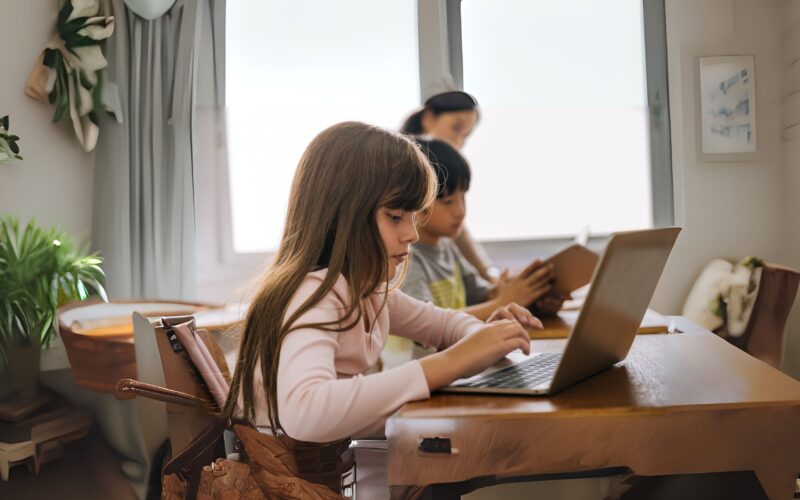As Martin Luther King Jr. once said, “The function of education is to teach one to think intensively and to think critically. Intelligence plus character—that is the goal of true education.” In today’s remote learning landscape, character development must include emotional resilience and mental wellbeing. That’s why supporting student mental health has become more critical than ever.
Virtual learning environments bring unique challenges—social isolation, screen fatigue, lack of structure—but also opportunities to rethink how we support students’ emotional and academic growth. In this article, we explore effective strategies schools can use to promote student wellbeing, build resilience, and create connected online communities.
1. Nurturing Student Resilience and Mental Health Online
Remote learning can take a toll on students’ mental health, especially when support systems feel out of reach. Schools can make a meaningful impact by embedding wellness practices into virtual classrooms.
Wellness Resources for Virtual Classrooms
Digital classroom wellness activities—like guided meditations, breathing exercises, and stress-reducing routines—help students manage anxiety and develop healthy coping skills. When woven into the school day, these small moments of calm build long-term resilience.
Virtual School Counseling Services
Offering online access to certified school counselors gives students a safe space to talk through emotional concerns. These sessions, delivered through secure video platforms, can help students navigate personal challenges, academic pressure, and social changes.
Engaging Digital Tools
Interactive mental health apps and educational videos can provide additional support. Tools focused on mindfulness, emotion tracking, or journaling empower students to take charge of their mental wellbeing.
2. The Power of School Community Engagement
A strong sense of school community reduces feelings of isolation and improves student mental health. Even in a remote environment, schools can foster belonging and connection.
Virtual Clubs and Events
From online book clubs to talent shows, extracurriculars help students build friendships and express themselves outside the virtual classroom. Hosting spirit days or digital assemblies also helps maintain school culture.
Collaborative Learning Opportunities
Group projects and peer-to-peer collaboration encourage teamwork and critical thinking while giving students a reason to connect and communicate. These interactions can help reduce loneliness and build social confidence.
Online Discussion Spaces
Creating safe, moderated forums for students to share ideas or ask questions builds a sense of shared learning. Whether it’s a class topic or a social check-in, open discussion promotes belonging.
3. Tackling Mental Health Challenges in Remote Education
Distance learning presents unique mental health challenges that schools need to address head-on.
- Isolation: The lack of face-to-face interaction can lead to loneliness. Consider buddy systems or regular peer group check-ins.
- Screen Fatigue: Prolonged screen time impacts mental and physical health. Build in offline assignments and movement breaks.
- Routine Disruption: Encourage students to establish daily routines with scheduled start times, breaks, and sleep hygiene tips.
- Emotional Distress: Equip educators to recognize signs of anxiety or withdrawal. Provide clear pathways to virtual counseling or support resources.
4. School Wellness Initiatives That Make a Difference
Holistic school wellness efforts support both physical and emotional wellbeing, which go hand in hand in a successful learning environment.
Promote Physical Activity
Incorporate stretch breaks or short home workouts during the school day. Host virtual fitness challenges to make movement fun and engaging.
Foster Mental Wellness
Introduce mindfulness practices, gratitude journaling, or creative activities that allow students to decompress. Ensure access to mental health resources and encourage open conversations about emotions.
Build a Connected Culture
Assign virtual learning partners or buddies. Use icebreaker games and digital classrooms with space for informal chat to mimic natural school socialization.
Create a Wellness Resource Hub
Build a dedicated page where families and students can find helpful content on nutrition, sleep, stress management, and more. Include workshops or webinars from community experts.
5. Practical Tips to Improve Student Wellbeing in Online Learning
Supporting student mental health in virtual learning environments requires proactive planning and flexibility.
- Maintain Clear Communication: Ensure students know how and when to reach teachers. Use chat tools, office hours, or discussion boards.
- Make Classes Interactive: Keep students engaged with polls, digital whiteboards, breakout groups, and live Q&A sessions.
- Stick to Predictable Schedules: Consistency reduces stress. Provide daily or weekly calendars with clear expectations.
- Provide Reliable Tech Support: Troubleshooting tech issues quickly prevents unnecessary stress and keeps students connected.
- Encourage Breaks and Movement: A short walk or stretch can reset a student’s mindset and boost focus.
6. Why Social-Emotional Learning (SEL) Matters More Than Ever
SEL equips students with the emotional intelligence they need to succeed—both in and out of the classroom. SEL also lays a foundation for long-term student mental health.
Key SEL Skills to Teach Remotely
- Self-Awareness: Encourage reflection through journaling or emotion check-ins.
- Stress Management: Teach deep breathing, visualization, and mindfulness techniques.
- Social Awareness: Use group activities to help students practice empathy and perspective-taking.
- Responsible Decision-Making: Guide students through reflective decision-making using real-life scenarios.
7. Virtual Student Support Systems
A strong support network is critical for students’ emotional wellbeing. Schools should develop virtual systems that replicate the structure and care of in-person learning environments.
Examples of Virtual Support Systems
- Online Counseling Access: Schedule private sessions with school counselors using secure platforms.
- Mental Health Education: Provide digital modules or videos that teach coping strategies, emotional literacy, and help-seeking behavior.
- Confidential and Safe Platforms: Ensure students feel secure when using online services by protecting their privacy and data.
- Teacher Involvement: Train teachers to recognize signs of emotional distress and connect students to appropriate support.
8. Building Resilience Through SEL in Remote Learning
Resilience isn’t just the ability to bounce back—it’s the strength to keep going, even when things get tough. SEL helps students build that inner strength.
Strategies to Build Resilience
- Daily Check-ins: Begin class with a quick emotional check-in to help students name and understand their feelings.
- Mindfulness Minutes: Start or end lessons with a short mindfulness activity to reset focus.
- Peer Collaboration: Facilitate cooperative projects that help students practice communication and problem-solving.
- SEL Lessons: Incorporate regular lessons on empathy, goal-setting, and managing frustration or disappointment.
Final Thoughts
The shift to remote learning doesn’t mean student mental health should take a back seat. On the contrary—it demands even more care and intention. By prioritizing wellness, nurturing resilience, fostering community, and integrating SEL, schools can support students not just academically but as whole people.
When students feel supported, connected, and understood, they’re more likely to succeed in any learning environment—virtual or otherwise. Let’s ensure that mental health becomes a permanent pillar of education, no matter where learning takes place



